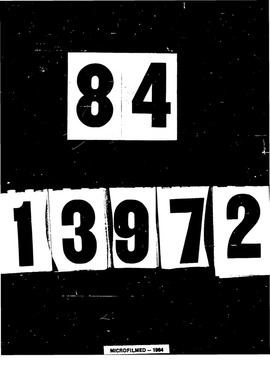| dc.contributor.author | Chang, Chun Kyung, | en_US |
| dc.date.accessioned | 2013-08-16T12:29:01Z | |
| dc.date.available | 2013-08-16T12:29:01Z | |
| dc.date.issued | 1984 | en_US |
| dc.identifier.uri | https://hdl.handle.net/11244/5204 | |
| dc.description.abstract | Until recently, most of the modeling studies on electricity demand have concentrated on the estimation of energy demand. Because capacity is built to meet system peak demand, utilities must be concerned in the maximum level of demand as well as the total energy to be consumed. | en_US |
| dc.description.abstract | A stock-adjustment model of peak load is developed in this study. The model is macroeconometric and therefore does not involve the problem of extensive data requirements. The model divides the process of electricity demand formation into: (1) the short-run characterized by variable utilization rates but fixed appliance stock, (2) the long-run adjustment featured by variable utilization and appliance stock adjustment and (3) the long-run equilibrium stage. The short-run demand has constant weather elasticity but variable price elasticity. The long-run adjustment model becomes a combination of the state-adustment model of Houthakker and Taylor and the geometrically distributed lag model of Koyck. Assuming the perfect adjustment of the appliance stock, elasticity of the load demand becomes larger in the long-run equilibrium stage for the economic and demographic factors in the model. | en_US |
| dc.description.abstract | The stock-adjustment model is empirically tested for the Lincoln Electric System using a time-series data for January 1969-December 1982. The estimation results are fairly reasonable and forecasting performance of the model is satisfactory. The model projections of annual peak load show that the utility will have a capacity shortage after 1994 without increase in power supply resources. The empirical study results do not support peak-load pricing. The model also can be used for evaluating some direct load control programs. | en_US |
| dc.description.abstract | Through an extensive survey of various peak load modeling techniques, the most refined and desirable way to model the peak load demand was determined to be an integrated end-use/econometric approach. However, the tremendous data requirements and model estimation efforts have discouraged utilities from adopting this hybrid modeling approach. The end-use/econometric model is viewed as a special case of the stock-adjustment model. Since the integrated model is a disaggregated version of the stock-adjustment model, the stock-adjustment model has the potential to evolve into an integrated model by increasing the level of disaggregation as more end-use and load research data become available. | en_US |
| dc.format.extent | vi, 140 leaves : | en_US |
| dc.subject | Business Administration, General. | en_US |
| dc.title | An econometric model of monthly peak load : | en_US |
| dc.type | Thesis | en_US |
| dc.thesis.degree | Ph.D. | en_US |
| dc.thesis.degreeDiscipline | Michael F. Price College of Business | en_US |
| dc.note | Source: Dissertation Abstracts International, Volume: 45-03, Section: A, page: 0886. | en_US |
| ou.identifier | (UMI)AAI8413972 | en_US |
| ou.group | Michael F. Price College of Business | |
